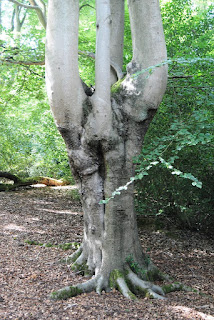The white box contains a landscape – bare branches, a night sky
set with stars, a window, a figure, curious objects.
We look in from outside.
The photo above shows the title page of a short collection called simply Landscapes that Harwood published in 1969. The poems do not have precise locations and places are remembered only haltingly. In ‘Question of geography’ he half recalls somewhere, ‘green a rich brown as the sun shone / turned to slate grey at times a soft blue smudge/ with dusk or rain clouds the detail obscured.’ These broad strokes remind me of Howard Hodgkin’s paintings, slowly worked on over the years whilst memories become overlaid and blurred. ‘You paint over the picture & start on / the new one but all the same it’s still there beneath the fresh plains of colour.’ Several poems in this book are ‘for Marian’ and sometimes the loved body and the landscape fuse: ‘When the sea is as grey as her eyes / On these days for sure the soft white / mist blown in from the ocean the town dissolving / It all adds up her bare shoulders…’ He writes about painting out in the landscape but can sound weary of the ‘the whole routine of bare / canvas & all the paints all squeezed out’. Next to the experience of another person, a seascape can seem superficial: ‘Sea coves & cliffs, the deserted beach - / they all mean so little / You are there & that is what it is.’ ‘When the geography was fixed’ begins with a view from a room of distant hills, which turns out to be a painting, so delicately done that it is almost a bare canvas. ‘The hill & the room are both in / the white. The colours are here / inside us I suppose.’
The book I had intended to write about here was 'Wine Tales', a collaboration with Ric Caddel. I was intrigued by its premise, to write short texts based on the images in wine labels. The wines chosen – Muscadet, Claret, Liebfraumilch – take me back to the time when my parents would choose a bottle from a Brighton supermarket to drink together a the weekend. I started making tasting notes and still have them, including one for Sainsbury's Rosé d'Anjou (£1.69, "pleasant, if undistinguished"), which was the source for one of the 'Wine Tales'. In a book of interviews Harwood described the genesis of the book:
'Ric was visiting me in Brighton and we were talking about the wonderful labels you used to get on wine bottles and the stories you could make up to go with them. I'd already done one from a Claret label. So we decided on a collaboration where one of us would choose a wine label, start a piece, send that to the other who would complete that piece. ... The idea was sparked by a poem by Raymond Roussel called 'La Source'. It's a long poem in strict verse form. A narrator is sitting in a restaurant with a bottle of mineral water and there's a scene, a landscape, on the bottle. He walks into the landscape. It's a long description of what he sees. Right at the end, he comes out of the label, back to the table in time for the waiter to arrive with his lunch.'

← part of a page from 'Wine Tales' (Galloping Dog Press, 1984)
my Rosé d'Anjou tasting notes from 1985 →
The reason I never finished my post on Lee Harwood and 'La Source' was that I did not have an English version of Roussel's poem. However, there is an English translation by Anthony Melville of 'La Vue', which Roussel published together with 'La Source' (and a third poem 'Le Concert') in 1904. 'The View' is a description over 2000 lines long of a tiny beach scene set into the lens of a pen-holder. The poet's eye focuses in on this seascape and begins to explore the view, encountering a fishing boat and a yacht with people standing about on deck, whose attitudes suggest their inner emotions and motivations. Returning to the beach he alights on a couple who are themselves gazing at the water – ‘their thoughts are far from the world; they are rapt before / The profound feelings they have poeticised.’ There is a dog chasing a stick, a kite up in the sky, walkers on the boardwalk, beach huts, rocks and a natural arch which perhaps resembles the one at Etretat, so popular with nineteenth century artists. Indeed there is a painter at work by this arch, oblivious to everything but a decision to be made over one precise spot in his picture.
The poem moves inland, up a road and into the villas that look out to sea, where a boy gazes at a lighthouse through a pair of opera glasses. Below the lighthouse there are more groups of people, lost in thought or watching the beach, like the poet, and his reader. ‘Their eyes are turned / Toward the sea’s edge, if not for the beauty / Of the waves, at least to watch some incident.’ They are like characters in Proust, whose narrator would recall similar scenes in À la recherche du temps perdu. Now as I write this, seeing that old wine label again, I am taken back to my own memories of the seaside at Brighton. Lee Harwood wrote 'yet another Brighton poem' in praise of its beach, which made him feel 'good and happy and so at ease in the world'. In Raymond Roussel's poem, the light finally goes down on the view, and the poet is left with his own ‘latent memories of a summer / Now dead, now far from me, fast blown away.'






